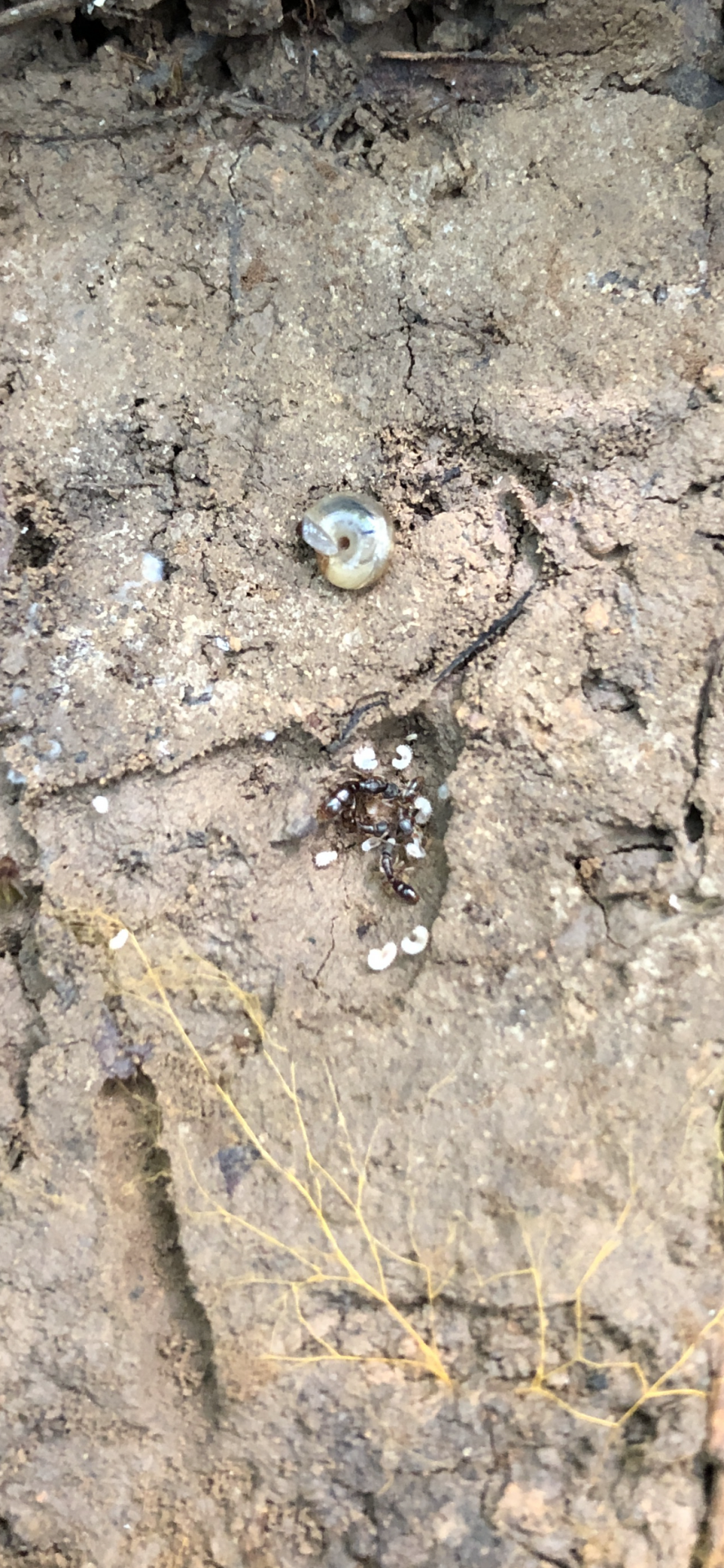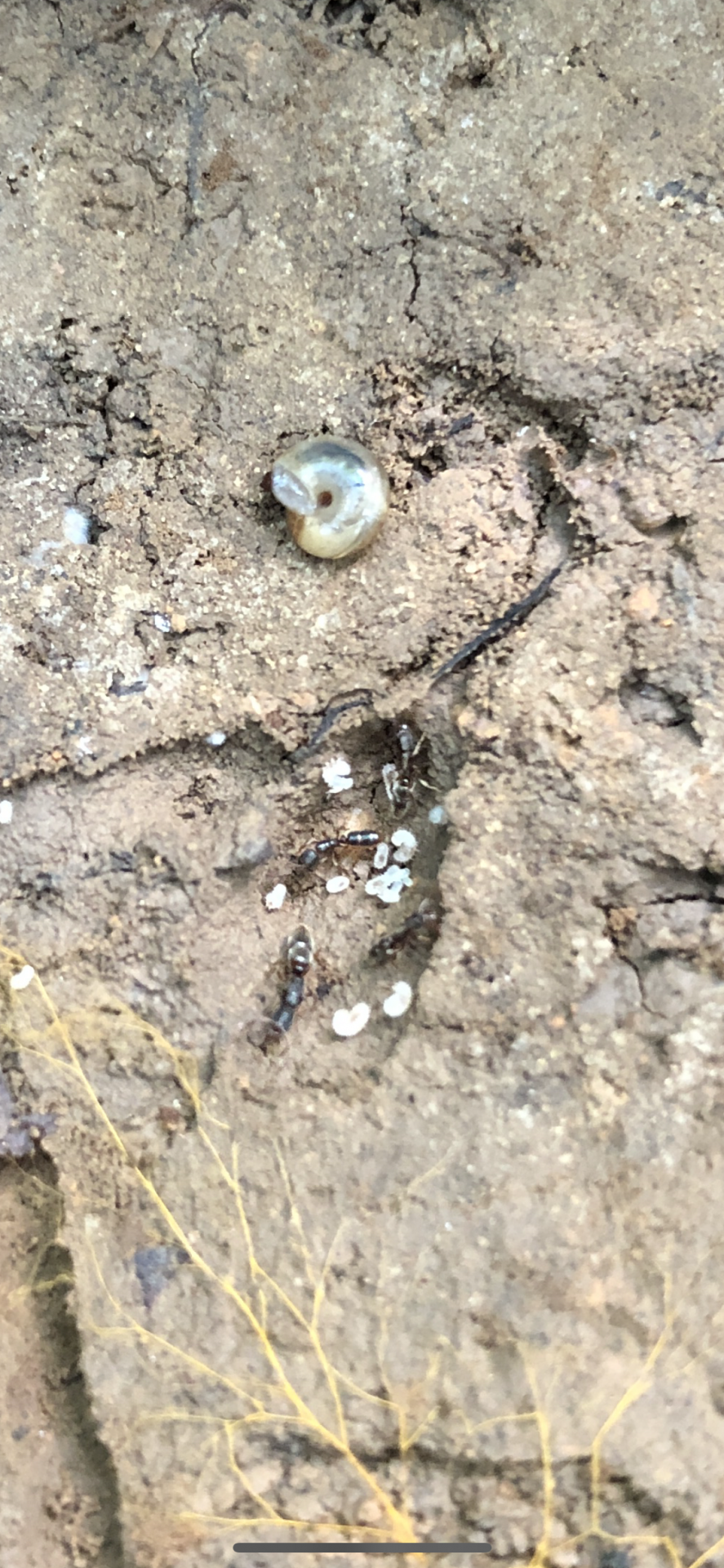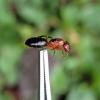- Formiculture.com
- Forums
- Gallery
- Members
- Member Map
- Chat

Southwest,VA any id
Started By
Jonny8040
, Aug 5 2020 8:00 AM
12 replies to this topic
#1
 Offline
-
Posted August 5 2020 - 8:00 AM
Offline
-
Posted August 5 2020 - 8:00 AM
Hey guys,
These little fellers are all over where I live. Super small and slow moving. Very yellowish pupae. Any idea what they are?
These little fellers are all over where I live. Super small and slow moving. Very yellowish pupae. Any idea what they are?
In Jesus,
Jonny
Jonny
#2
 Offline
-
Posted August 5 2020 - 8:04 AM
Offline
-
Posted August 5 2020 - 8:04 AM
Those are either Ponera or Hypoponera.
My Main Journal | My Neivamyrmex Journal | My Ant Adoption | My YouTube
Join the TennesseeAnts Discord Server! https://discord.gg/JbKwPgs
#3
 Offline
-
Posted August 5 2020 - 8:04 AM
Offline
-
Posted August 5 2020 - 8:04 AM
Ponera pennsylvanica. The large one is a queen.
My journals:
Polyergus Mexicanus: https://www.formicul...gs/#entry175528
Lasius minutus: https://www.formicul...cs/#entry174811
Lasius latipes: https://www.formicul...gs/#entry206449
General acanthomyops journal: https://www.formicul...yops-with-eggs/
Polyergus Mexicanus: https://www.formicul...gs/#entry175528
Lasius minutus: https://www.formicul...cs/#entry174811
Lasius latipes: https://www.formicul...gs/#entry206449
General acanthomyops journal: https://www.formicul...yops-with-eggs/
#4
 Offline
-
Posted August 5 2020 - 8:07 AM
Offline
-
Posted August 5 2020 - 8:07 AM
Thank you all! Is there a care sheet on these guys?
In Jesus,
Jonny
Jonny
#5
 Offline
-
Posted August 5 2020 - 8:07 AM
Offline
-
Posted August 5 2020 - 8:07 AM
Ponera pennsylvanica. I don't see any pupae, just larvae.
#6
 Offline
-
Posted August 5 2020 - 8:30 AM
Offline
-
Posted August 5 2020 - 8:30 AM
Ponera pennsylvanica. I don't see any pupae, just larvae.
There wasn’t pupae in this colony but in another one I flipped over
In Jesus,
Jonny
Jonny
#7
 Offline
-
Posted August 5 2020 - 8:31 AM
Offline
-
Posted August 5 2020 - 8:31 AM
Cool find.
Ants I have: Tapinoma sessile(2 queen colony). RED MORPH Camponotus neacticus(now has pupae!), Tetramorium immigrans (x3), Aphaenogaster sp, Temnothorax sp, Brachymyrmex sp. possibly infertile ![]() , Ponera pennsylvanica, and Pheidole morrisi!
, Ponera pennsylvanica, and Pheidole morrisi! ![]()
Other insects: Polistes sp. Queen
Ants I need: Pheidole sp., Trachymyrmex sp., Crematogaster cerasi , Dorymyrmex sp. Most wanted: Pheidole morrisii
#8
 Offline
-
Posted August 5 2020 - 9:39 AM
Offline
-
Posted August 5 2020 - 9:39 AM
That's a cool species! Nice find!
#10
 Offline
-
Posted August 5 2020 - 10:58 AM
Offline
-
Posted August 5 2020 - 10:58 AM
they'll take dead things as well, and perhaps some sugars.
#11
 Offline
-
Posted August 5 2020 - 3:06 PM
Offline
-
Posted August 5 2020 - 3:06 PM
don't they only eat springtails usually?
My journals:
Polyergus Mexicanus: https://www.formicul...gs/#entry175528
Lasius minutus: https://www.formicul...cs/#entry174811
Lasius latipes: https://www.formicul...gs/#entry206449
General acanthomyops journal: https://www.formicul...yops-with-eggs/
Polyergus Mexicanus: https://www.formicul...gs/#entry175528
Lasius minutus: https://www.formicul...cs/#entry174811
Lasius latipes: https://www.formicul...gs/#entry206449
General acanthomyops journal: https://www.formicul...yops-with-eggs/
#12
 Offline
-
Posted August 5 2020 - 5:01 PM
Offline
-
Posted August 5 2020 - 5:01 PM
don't they only eat springtails usually?
Not at all. They'll take other small soil fauna as well as some sugars, will likely scavenge larger animals, and may even hunt very large prey when the colony is large enough. The latter 2 points are based on my own observations with Hypoponera, where they actually seem to get a lot of protein from dead invertebrates and will take on large arthropods such as juvenile earwigs, small centipedes, and spiders. However behavior between the 2 should be similar enough that we can assume Ponera will do the same or roughly the same.
#13
 Offline
-
Posted August 6 2020 - 7:38 AM
Offline
-
Posted August 6 2020 - 7:38 AM
My queen has survived for months off of pieces of dubia roaches and crickets.
1 user(s) are reading this topic
0 members, 1 guests, 0 anonymous users






















